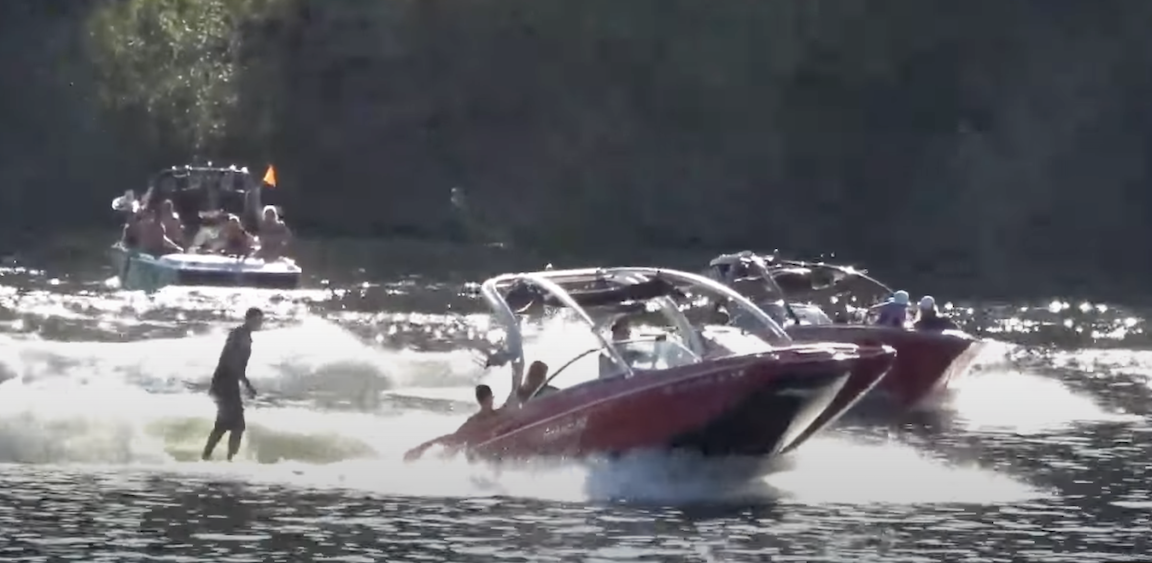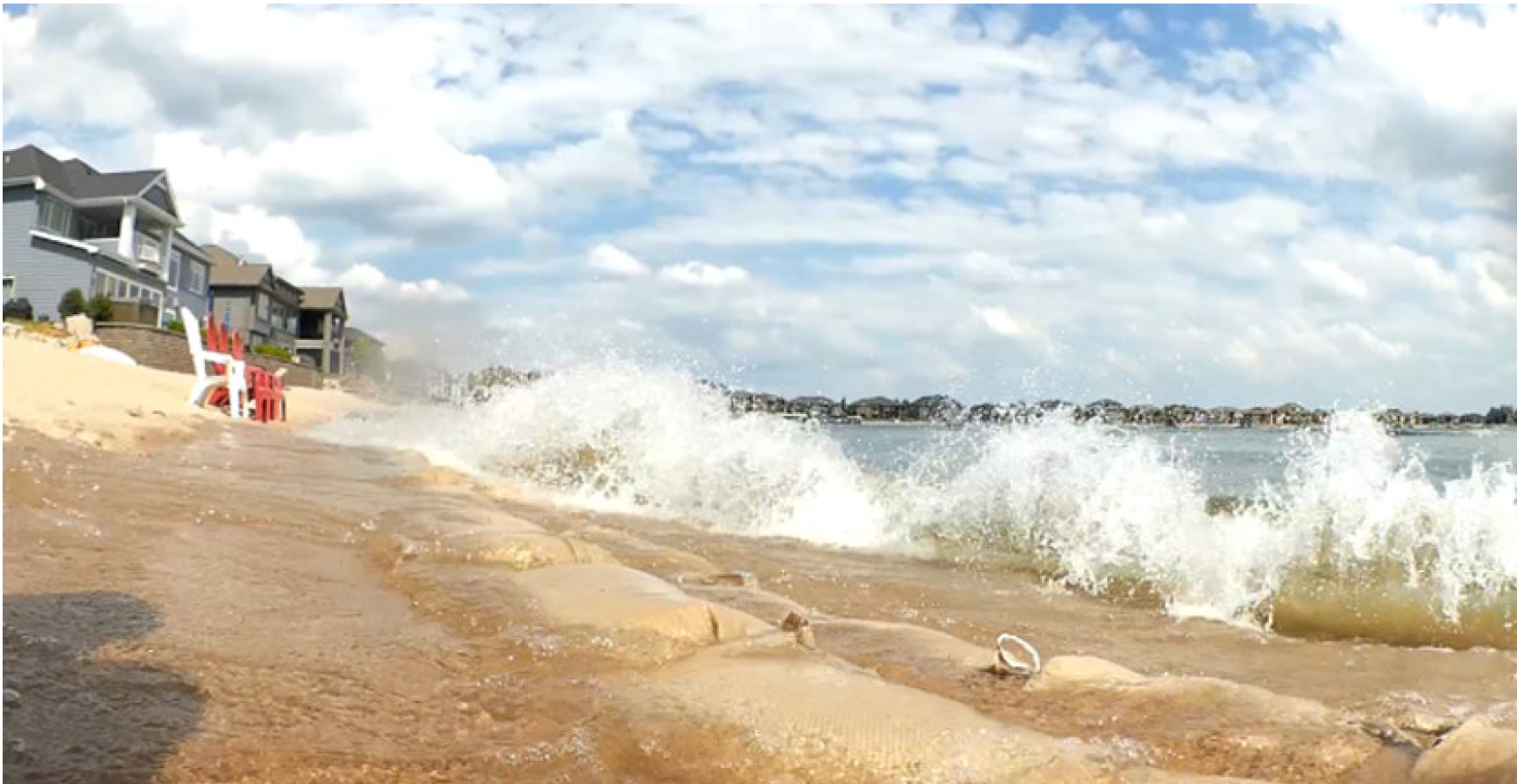Vermont continues to learn about wake boats from the experience around the country. We need to listen. The stories are chilling. In Vermont, wake sports are just beginning to take hold. But we ignore them at our peril. They are coming. They are gaining in popularity. The boats are getting bigger and heavier and more powerful every year. And people around the country are warning us: “Stop them now before they take over! Once they have established themselves on your lake, you will never be able to get rid of them.” What follows is testimony from four people with stories to tell from their home lakes.

Multiple wake boats on busy summer day on the water (Photo: Bert Krages)
Georgia’s Lakes Rabun and Burton— Comments of resident Wallace Bruce
In the 39 years my family has lived on our once idyllic, clear mountain lake in the Northeastern Georgia Appalachian foothills, our two large, narrow flooded river valley lakes have witnessed tremendous increases in wake boat activities — along with significant undesirable impacts. On my Lake Rabun (835-acres) we currently have 125 wake boats (12% of all boats on the lake); on our sister Lake Burton (2,700-acres) there are several hundred such boats. In 2020, our two lake associations became so concerned about unsafe boating conditions and the adverse effects of wake boating (i.e., increases in shoreline erosion and collateral damage to docks or other vessels) that we raised $40,000for an engineering study. At the same time, Lake Rabun’s Lake Association did a survey our 500-member homeowner families. Of the 999 member comments received, 70% which were negative regarding wake boats. These were incorporated in the 2020 consultant’s report, Boat Wake Impact Analysis. The report confirmed our safety and adverse wake boat impact fears. I should mention that whereas pre-wake boats, water clarity had extended down to 20-40 feet during summer months, Lake Rabun today is uniformly murky during the heavy wake boat traffic summer months. During busy summer weekends, wake boats make it practically impossible for other watercraft and swimmers to enjoy safe and pleasant water activities. This is especially true when more than one wake boat at a time operate in the same area. A few examples of summer safety and property damage incidents with wake boats include:
- A passenger in a boat who was thrown about by wakesurfing waves required a visit to our local hospital emergency room.
- An idling boat was thrown against a lake seawall by wakesurfing waves. This cracked its hull so that the boat sank.
- A man in a rowing scull was almost run over by a wake boat in surfing mode because the high bow angle obscured the driver’s forward vision.
- A 7-year-old boy was washed out of a wake boat (i.e., the Malibu Response LX in the link below) that was swamped by its own wake by an inexperienced driver who reversed course too quickly and plowed into its own wake. The boy died as a result of becoming entangled in the boat’s unguarded propeller.
Nebraska’s Mallard Landing Lake — Comments of resident Kris & Jerry Holmes
We live on a 90-acre lake in Nebraska that allows various boating activities. In seven years, we went from two wake boats to 30 wake surfing boats. On a lake the size of ours, one ballast boat is too many. Our water quality has suffered, and wakes are so large at times that it becomes difficult to dock our pontoon boat and that normal non-wake boat water activities become unsafe. We have documented over 100 passes by these boats in a single day. As can be seen in the photo below, these waves tear up the shorelines and pull up the vegetation used for fish habitat. No other boating activities have such a negative impact on our lake like ballasted boating does. Tubing or water skiing with a wake surfing boat will still create a larger wake than a water skiing or pontoon boat due to the hull design on wake boats. We have lost immeasurable amounts of sand along the shore; our once clear lake is no longer as clean and clear as it was. We have suffered algal blooms in large part due to the prop wash disturbing and resuspending sediments in the water column. We have spent thousands of dollars removing sand from under our boat lifts, repairing docks and have spent $250k to shore up the island on our lake which looks to be at risk yet again. We are the poster child of what not to allow to happen to your lake. Once wake boats get on there, you cannot remove them. Our HOA is comprised of nine members, five of which own wake boats. They have control of the board and vote together. We have sent them the wake studies and they refuse to do anything to address our concerns. Here is a photo of a wake boat wake crashing the shoreline of our lake.

Wake boat waves crashing on the vegetation-absent shore of Mallard Landing Lake (photo: Kris Holmes).
Minnesota’s Christmas Lake — Comments of resident Joe Shneider
I live on Christmas Lake, a 264-acre lake just outside of Minneapolis. We are being increasingly inundated by wake surf boats on our lake; a dozen lake residents operate their own while transient wake boaters come by for the day. Wake surfing has become a significant, polarizing issue on Christmas Lake, just as it has on many small Minnesota lakes. This is because you can’t avoid the impacts to others who want to use the lake at the same time. Personally, I have had waves crash over the bow of our pontoon boat and I have been tossed around when trying to paddle board. Lake residents know it’s useless to try to waterski when one or more surf boats are operating. Perhaps of greatest concern, we’ve had a near-fatal accident between a boat, nose up in the air with a surfer behind, crashing into a 2-person kayak. Some lakes — like ours — are just too small for this kind of activity.
North Carolina’s Lake Auman — Comments of resident Paul Brezinski
Lake Auman, an 800-acre spring-fed lake – and its ½ mile long earthen dam — are owned entirely by the community and managed by a private homeowner’s association (HOA). The HOA board, and most supporting committees, fell into the hands of wake boat enthusiasts while the community slept. A community group formed in opposition and was forced to take the Board to court (and won!) because the board relied on illegal votes for the 2021 election. The HOA Board also voted down consideration of a a university-led study of both surface and subsurface wave energy. In just a few years, Lake Auman went from having about 19 wake boats to its current number closing in on 100. The lake has a designated ski area occupying the center of the lake, which results in a concentrated smaller area (around 250 acres or so) at the center. The lake is also bulkheaded along the shoreline, causing wave energy to reflect back into and across the lake. As a result, even one active wake boat can often mean that others are not able to enjoy the lake. Roughly five years, and one lawsuit later, the community voted in a completely new Board that is once again pursuing a study to assess the health of the lake and to identify factors that negatively impact said health, including wave energy, and mitigating strategies for those threats.
